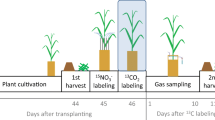Summary
The objective of this experiment was to determine, by electrical analog, how oxygen movement to plant roots is affected by two variables: the depth of the plow layer (depth of tillage) and the depth of the roots in the plow layer. The analog was developed for a row crop that had a long, narrow, vertical sheet of roots. Oxygen moved from the cultivated soil surface to the sheet of roots. Plow-layer depth (depth of soil cultivated) was 20, 10, 5 or 2.5 cm. Depth of the root sheet was 20, 10, 5, 2.5, 1.25, 0.625, or 0cm. Dimensionless values for flow of oxygen were determined and compared to theoretical values.
Experimentally determined dimensionless flow values agreed with those determined theoretically, which showed that the model simulated expected values for oxygen transport. As the depth of the root sheet increased, movement of oxygen to the roots increased curvilinearly. Roots that penetrated only a small distance into the plow layer took up large amounts of oxygen. As the depth of the plow layer increased, oxygen movement to the root sheet increased. The results suggested that, for maximum flow of oxygen to the root sheet, a deep plow layer is more important than a deep root sheet.
Similar content being viewed by others
References
Barber S A 1984 Soil Nutrient Bioavailability. A Mechanistic Approach. John Wiley and Sons, New York, 398 p. (See p. 153)
Bernstein L, Gardner W R and Richards L A 1959 Is there a vapor gap around plant roots? Science 129, 1750 and 1753 (two pages).
Clarkson D T 1974 Transport and Cell Structure in Plants. John Wiley and Sons, New York, 350 p. (see p. 410 and 282)
Gardner W R and Ehlig C F 1962 Impedance to water movement in soil and plant. Science 138 522–523.
Geisler G and Ferree D C 1984 Response of plants to root pruning. Hortic. Rev. 6, 155–188.
Geisler G and Maarufi D 1976 Investigations on the importance of the root systems of cultivated plants. II. The influence of root trimming on plant growth, root morphology, transpiration and nitrogen uptake in relation to the soil water content and nitrogen fertilization. J. Agron. Crop Sci. 143, 1–17(In Ger., Eng. sum).
Gilmont R and Wechsler L I 1986 Electrical resistivity of absolute water calculated from the ions. Am. Lab. 18, 70–82.
Gliński J and Stepniewski W 1985 Soil Aeration and Its Role for Plants. CRC Press, Inc., Boca Raton Florida, 229 p. (See p. 46, 48, 152–161 189).
Higgs R, Heidenreich C, Loberger R, Cropp R and Mitchell M 1981 Agricultural Mathematics. Second Ed. The Interstate Printers and Publishers Inc., Danville, Illinois, 297 p. See p. 69)
Insley H and Buckley G P 1985 The influence of desiccation and root pruning on the survival and growth of broadleaved seedlings. J. Hortic. Sci. 60, 377–387.
Kirkham D 1986 Unpublished.
Kirkham D and Powers W L 1984 Advanced Soil Physics. Reprint Ed. (Revised). Robert E. Krieger Publishing Co., Malabar, Florida, 534 p. (See p. 46, 74–75)
Kirkham M B 1986 Simulation of oxygen movement to plant roots as affected by tillage width and depth. Soil Tillage Res. 7, 221–231.
Mitchell R L 1970 Crop Growth and Culture. The Iowa State University Press, Ames, Iowa, 349 p. (See p. 109, 118–120)
Peterson, V 1981 Optimum planting practicesIn Grain Sorghum Handbook. Coop. Ext. Service Pub. No. C-494 (Revised). Kansas State Univ., Manhattan, Kansas, pp 5–7.
Taylor S A 1949 Oxygen diffusion in porous media as a measure of soil aeration. Soil Sci. Soc. Am. Proc. 14, 55–61.
Thompson C A 1983 Super thick sorghum management. Rep. of Progress No. 437. Agr. Exp. Sta., Manhattan, Kansas, 24 pp.
United States Department of Agriculture 1985 Agronomic practices for protection fromStriga asiatica.In 1984 Annual Report, Whiteville Methods Development Center. U.S. Dep. Agr., Anim. Plant Health Inspection Service, Plant Protection and Quarantine, Whiteville North Carolina, pp 98–99.
United States Salinity Laboratory Staff 1954 Diagnosis and Improvement of Saline and Alkali Soils. Agr. Handbook No. 60. U.S. Dep. Agr., Washington, D.C., 160 p. (See p. 11)
Warrick A W and Kirkham D 1969 Two-dimensional seepage of ponded water to full ditch drains. Water Resources Res. 5, 685–693.
Weast R C 1964 Handbook of Chemistry and Physics. 45th Ed. The Chemical Rubber Co., Cleveland, Ohio, (pages not numbered sequentially). (See p. F-84)
Wesseling J and van Wijk W R 1957 Soil physical conditions in relation to drain depth.In Drainage of Agricultural Lands. Ed. J N Luthin. Am. Soc. Agronomy, Madison, Wisconsin, pp 461–504.
Author information
Authors and Affiliations
Rights and permissions
About this article
Cite this article
Kirkham, M.B. Soil-oxygen and plant-root interaction: An electrical analog study. Plant Soil 100, 11–19 (1987). https://doi.org/10.1007/BF02370929
Issue Date:
DOI: https://doi.org/10.1007/BF02370929



